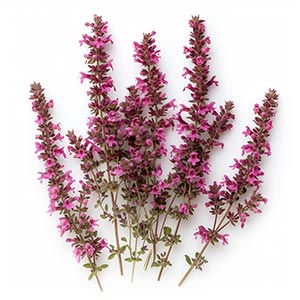Red Thyme, scientifically known as Thymus serpyllum, is a key ingredient in perfumery, known for its distinctive, herbaceous aroma. It is a small, perennial plant in the mint family, characterized by its tiny, fragrant leaves. Red Thyme adds a unique, slightly spicy, and herbaceous character to fragrances. It is especially valued in aromatic and herbal fragrance compositions. Its scent profile is complex, featuring a blend of earthy, woody, and floral nuances with a touch of sweetness, making it a versatile note in perfumery. Historically, Thyme has been used for its aromatic properties since ancient times. Its inclusion in modern perfumery continues this tradition, offering depth and complexity to a wide range of scents. Red Thyme is often used in the top and middle notes of a fragrance, contributing to the initial impression and the heart of the scent.
Natural or Synthetic?
Red Thyme is utilized both in its natural form and as a synthetic compound in perfumery. The natural oil is extracted from the leaves of the Thymus serpyllum plant, usually through steam distillation. This process captures the essential oils while preserving the characteristic scent of the herb. However, due to variability and the limited yield of natural extraction, synthetic versions of Red Thyme are also produced. These synthetic variants provide consistency and are often more cost-effective. They are created to mimic the natural scent of Thyme and can be used to enhance or complement the natural oil in a fragrance formula.
Fragrance Families Red Thyme Most Commonly Found In
Show fragrances that contain Red Thyme as a note



